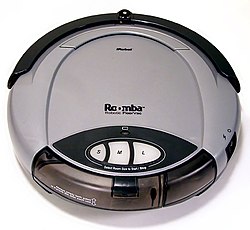
Back Roomba Catalan Roomba Czech Roomba German Roomba Esperanto Roomba Spanish Roomba Basque جاروی رومبا Persian Roomba French Roomba Hungarian Roomba ID
This article has multiple issues. Please help improve it or discuss these issues on the talk page. (Learn how and when to remove these messages)
|
 Original Roomba from 2002 | |
| Type | Robotic vacuum cleaner |
|---|---|
| Inception | 17 September 2002 |
| Manufacturer | iRobot |
| Models made | See list |
| Website | https://www.irobot.com/en_US/roomba.html |
| Part of a series on |
| Automation |
|---|
| Automation in general |
| Robotics and robots |
| Impact of automation |
| Trade shows and awards |
A Roomba is an autonomous robotic vacuum cleaner made by the company iRobot, and was first introduced in September 2002.[1] Roombas have a set of sensors which help them navigate the floor area of a home. These sensors can detect the presence of obstacles and steep drops (e.g., to avoid falling down stairs).
As of 2024, iRobot markets models of their fourth through tenth generation, while continuing to provide support and to sell accessories for their previous series.[2] Various models of the Roomba have different features, including tangle-free brushes, separate sweep canisters, more powerful vacuums, obstacle avoidance, and performance maps displayed via smartphone apps. Newer models also have a camera, which works in conjunction with onboard mapping and navigation software to systematically cover all floor areas, move from room to room, avoid obstacles such as pet waste and charging cables, and find recharging stations.[3]
Roombas allow some modulation and reprogramming. Parts of some models are interchangeable, allowing owners to mix and match features or switch to other units for longer battery operation. Additionally, some units can be adapted to perform more creative tasks using an embedded computer in conjunction with the Roomba Open Interface.
In August 2022, Amazon announced its intention to purchase iRobot, though the acquisition was delayed by regulators in Europe for fear of hurting competition. As of January 2024, these plans were abandoned by Amazon.[4]
- ^ "iRobot Corporation:Our History". Irobot.com. Archived from the original on 2012-01-03. Retrieved 2013-11-24.
- ^ "Roomba Robot Vacuum Cleaners | iRobot®". irobot.com. Retrieved 1 August 2021.
- ^ "Roomba Keeps Cleaning the Same Area (12 Reasons and 10 Fixes)". 2022-03-04. Retrieved 2023-05-03.
- ^ Satariano, Adam (2024-01-29). "Amazon Scraps Deal to Buy Maker of Roomba Amid Regulatory Scrutiny". The New York Times. ISSN 0362-4331. Retrieved 2024-03-07.